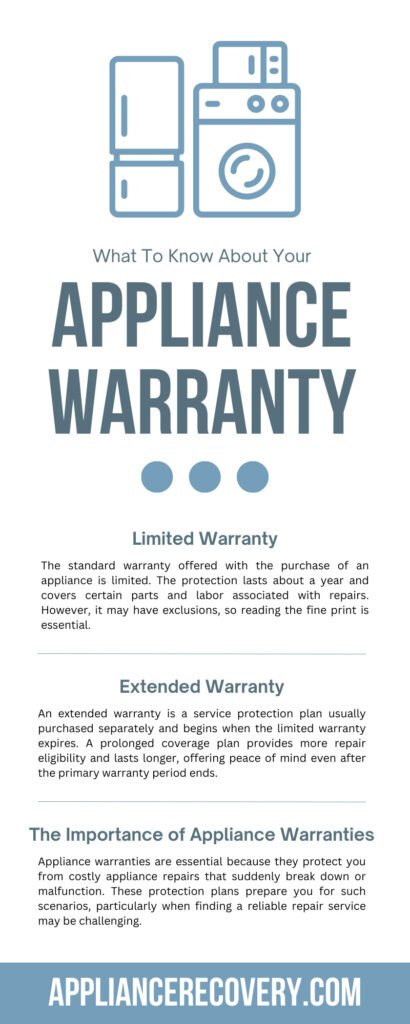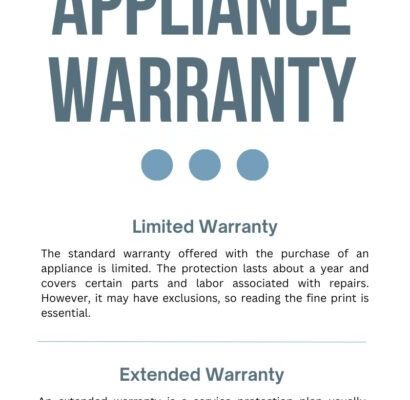
So let’s talk real talk about your GE laundry appliance warranty. Think of it as a “promise” from GE: if something’s their fault, they’ll fix it. But there are rules to keep that promise valid—and not all of them are as obvious as you’d think. Whether you’re new to fancy washers or just never read the fine print, knowing how to avoid voiding your GE appliance warranty can save you a world of hassle and cost.
Understand What Your GE Laundry Appliance Warranty Actually Covers
Here’s the thing: a lot of people assume a warranty is a magic shield. But when it comes to GE washers and dryers, the warranty only covers specific problems—usually defects in materials or workmanship, not just anything that goes wrong. Honestly, the fine print can feel like reading a different language, but it’s worth the effort.
GE’s *standard warranty* for most laundry appliances tends to cover parts and labor for a set time, like one year. Some components, like washer drums or dryer motors, might be covered longer. But coverage doesn’t mean carte blanche. If parts break due to misuse, accidents, or non-GE parts, you’re probably out of luck. Imagine dropping your phone in a lake—even with a warranty, that’s a you problem.
Before you start tinkering, ask yourself: is this issue from normal use, or did I overload, slam, or “MacGyver” something? The warranty usually only applies to defects, not damage you cause—even by accident. Reading the actual warranty booklet (yes, the paper tucked in the box or the PDF online) is key. Highlight what *isn’t* covered, and keep that in the back of your mind every time you do laundry, maintenance, or troubleshooting.
Always Register Your Appliance—And Keep Records Handy
You might be wondering, “Does registration actually matter?” Absolutely. Registering your GE laundry appliance is like giving GE your receipt in advance. It makes it much easier to prove you’re the original owner and that your warranty is active. If you skip this step, warranty service could turn into a headache, with you digging through old emails or trying to remember where you bought your washer.
Here’s what you want to do:
- Go to GE’s official website and look for the “register your appliance” page.
- Input your model number, serial number, and purchase date. (These are usually on a sticker inside the door or back panel.)
- Upload your proof of purchase if possible. Snap a picture of your receipt and save it somewhere safe, too.
I know registration isn’t the most thrilling task, but it pays off if you ever need to make a warranty claim. Also, hold onto any service records, installation documents, or repair notes. If there’s ever a question about when your warranty started, or which “code” issue happened when, you’ll have backup.
Professional Installation Is Key—Don’t DIY Unless You Know What You’re Doing
Let me explain why installation is such a big deal. Picture trying to put together a complicated LEGO set without instructions—sure, you might end up with something, but if it falls apart, can you blame LEGO? That’s how GE looks at improper installation. If you DIY your washer hookup and get the wiring or water lines wrong, you could void your warranty before you even do your first load.
GE usually requires that appliances be installed according to their official instructions—sometimes even by a licensed pro. For certain models, things like stacking kits or venting must be GE-approved parts. If you use the wrong parts, or skip a crucial step (like balancing the washer), any resulting damage probably won’t be covered.
So if your skills are more “IKEA bookshelf” than “certified electrician,” it might be best to let the pros handle it. Saving a bit on installation now can cost a ton later if a voided warranty means paying out of pocket for repairs. Whenever you move, remodel, or even just swap hoses or cords, double-check the manual—or call a GE service tech for advice.
Use Only GE-Approved Parts and Accessories
You might see tempting deals on off-brand hoses, filters, or stacking kits, but here’s why that’s a risky move: GE’s warranty usually doesn’t cover failures from third-party parts. The logic is simple—if a $5 knockoff part breaks and floods your laundry room, that’s not GE’s responsibility. Using non-GE components can cause issues with the appliance’s electronics, code errors, or even fires.
This also goes for batteries in smart remote controls or WiFi modules. If something needs replacing, stick with GE-recommended or officially compatible parts. The same goes for detergents—using harsh or non-HE soap can damage the washer’s sensors, leading to code problems or breakdowns that aren’t covered.
Bottom line: when in doubt, check the manual or call GE support. Don’t assume a “universal” part is truly safe for your machine. Cutting corners here might save you a few dollars today, but you could pay way more in the long run by voiding your warranty.
Don’t Attempt Unauthorized Repairs or Modifications
I get it—YouTube makes fixing things look easy, and nobody wants to pay for service if they don’t have to. But with GE laundry appliances, opening up the control board or taking apart the drum on your own is a fast-track to a voided warranty. Even “minor” repairs, like swapping out fuses or trying to reset an error code by disconnecting the main circuit, can get you in trouble.
GE’s warranty almost always requires that *authorized technicians* handle repairs during the warranty period. Why? Because modern washers and dryers are loaded with electronics, sensors, and proprietary code. Tinkering, even with the best intentions, can make things worse—and GE can easily tell if something was tampered with. If your appliance has a sealed sticker or security tab, breaking it is basically waving goodbye to your coverage.
If your machine is acting up, try the basic troubleshooting steps in the manual—like unplugging, checking the breaker, or pressing the *reset* button if equipped. But don’t go further unless you’ve gotten the green light from GE customer support or a certified tech. Keep all records of service calls, even if the visit seems routine.
Stay Up to Date With Basic Maintenance (But Don’t Overdo It)
Here’s a tricky one: not doing routine maintenance *can* void your GE warranty—but so can going overboard or using the wrong methods. Appliance warranties often have a clause stating you must use your machine “as intended” and follow care instructions. Ignoring lint trap cleaning, letting water hoses get crusty, or failing to level your washer could all be used as reasons to deny coverage.
Typical maintenance that’s required:
- Cleaning the lint trap or filter after every load
- Running periodic washer cleaning cycles with approved cleaners
- Checking and tightening hoses for leaks or wear
- Keeping the machine level and stable
But don’t get creative—using strong chemicals, power tools, or “life hacks” you found online can easily damage your appliance or trip a code. Stick to the maintenance instructions in your owner’s manual. If GE recommends a specific cleaning product or method, use it. Record when you do required maintenance—snapping phone photos can help if you ever need to show you’ve taken good care of your appliance.
Avoid Misuse and Accidental Damage—Follow Manufacturer Guidelines
It sounds obvious, but a shocking number of warranty claims get denied for “misuse.” Overloading your washer, washing heavy rugs, or ignoring error codes (like a persistent “unbalanced” warning) can all qualify. Think of your GE laundry appliance as a tool—it’s tough, but it’s not invincible.
Don’t use your washer or dryer for anything it’s not designed for—no washing pet beds, sneakers, or rubber-backed rugs unless the manual says it’s okay. If the appliance goes haywire (random beeps, failure to sync with the remote, flashing code errors), stop and troubleshoot using the official steps. Forcing it to run or trying to override safety features could make a small problem much bigger—and unprotected.
Also, watch out when moving or cleaning around your machine. Accidentally hitting the control panel, scratching the finish, or letting water spill into electrical parts can all disqualify you from warranty protection. Whenever in doubt, ask: “Would GE expect me to use it this way?” If not, don’t risk it.
Contact GE Support Promptly If Problems Arise
You might be tempted to ignore little glitches or code errors, assuming they’ll just work themselves out. But here’s why that’s not a great idea: the longer you wait to report a potential defect, the harder it becomes to prove when and why it happened. GE’s warranty terms often require you to report problems “promptly.” Waiting months can mean losing your window for warranty service.
If your laundry appliance starts making weird noises, refusing to pair or sync with a smart remote, or flashes an error code you don’t recognize, reach out to GE support right away. Take note of the model, serial, and any error codes displayed—this helps the support team troubleshoot quickly and accurately.
If a technician visit is needed, make sure it’s with a GE-authorized pro. Keep all notes from emails, calls, or service appointments. That paper trail protects you if there’s ever a dispute about when the issue started or whether you followed the correct steps to resolve it.
The quickest way to void your GE laundry warranty isn’t a single big mistake—it’s a series of little “oops” moments. Being proactive, careful, and aware of the rules is the best way to keep that safety net in place.
Wrapping It All Up: Protect Your GE Warranty Like It’s Your Backup Plan
It’s easy to think of warranties as just another hoop to jump through, but honestly, keeping your GE laundry appliances covered can mean the difference between a minor hiccup and a huge out-of-pocket repair. Treat your washer and dryer’s warranty like an emergency parachute: you hope you never need it, but you definitely want it in working order just in case. Register your appliance, stick to GE’s recommended care, and call in the pros for anything beyond basic troubleshooting.
If you ever feel unsure about what’s covered or what’s not, don’t go it alone—call GE support and ask. It’s always better to sound a little paranoid than to end up on the hook for something costly. With a little care and attention, you can keep your GE warranty active and your laundry days a little less stressful.
